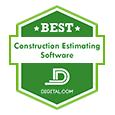The success of any residential construction project starts with an accurate, organized, and detailed estimate. Whether you are new to residential construction estimating or experienced, it's easy to overlook small details that can cause big problems later. This guide covers everything you need to include in your estimate, from materials and labor to permits and inspections. We’ll also discuss best practices to help you stay on track, highlight free construction estimate templates, and point out common mistakes to avoid.
Preparation is key. Before estimating, research prices and understand your project's full scope. Using residential construction estimating software can make this process easier and more accurate. As the project progresses, track actual costs and compare them to your estimate to stay on budget and make informed decisions. By following the 8 tips in this guide, you can ensure your residential construction project runs smoothly from start to finish.
1. Determine Which Pricing Model You’ll Be Using
In residential construction, there are three main pricing models. These are known as Cost-Plus, Fixed Price, and Unit Price. Each of these has its pros and cons and will determine how you build your estimate and your proposal. How your team communicates with clients and tracks costs also can be dependent on the pricing model.
Cost-Plus
Cost-plus pricing is a method used in construction projects where the contractor is paid for all construction-related expenses plus an additional fee to ensure a profit. This extra amount is often a percentage of the total costs, but can also be a fixed fee. Cost-plus pricing is growing in popularity as material costs continue to fluctuate.
This method is useful when project costs are hard to predict because it makes sure the contractor gets paid for any unexpected expenses. However, it requires careful tracking of all costs to show the client the final price. Cost-plus contracts usually require more financial transparency with clients than other models.
Fixed-Price
Fixed-price pricing in construction means the contractor agrees to complete a project for a set amount of money. This price is decided before the project starts and stays the same, no matter what happens during construction. Oftentimes, contractors that follow a fixed-price model will include allowances for costs that fluctuate often.
This method benefits clients because they know the total cost from the beginning, reducing the risk of unexpected expenses. It also often allows for higher profits for the contractor but with higher risks. If costs go up or problems arise, the contractor has to cover those costs without charging extra - with the exception of change orders. This makes careful planning and accurate cost estimation at the opportunity stage very important for the contractor.
Unit-Price
Unit price pricing in construction involves charging a set amount for each unit of work completed. For example, a contractor might charge a specific price per square foot of flooring installed or per cubic yard of concrete poured.
This method is useful for projects where the amount of work can be easily measured and counted. It allows clients to see how much each part of the project will cost and makes it easier to adjust the total price if the project size changes. However, it requires accurate estimates of the quantities needed to avoid surprises in the final cost.
2. Organize Your Estimate
As a contractor planning a residential construction project, categorizing necessary costs is crucial for keeping everything organized and within budget. No matter what size your estimate is, be sure to organize it properly so that line items can be found easily and nothing gets lost. We recommend organizing your estimate by categories and subcategories. After your structure is laid out, be sure to include as much detail as possible as you add line items.

Categories
Categories will be the first level of organization. Oftentimes construction estimators will organize their categories by stage, divisions, areas of work, etc. However, it is important to label categories so that they are easy to navigate. That may be different for your company, so be sure to label them according to your needs.
Subcategories
Within the categories, estimators can also determine subcategories. These further help to identify costs and find specific line items. Subcategories are often identified by additional details for the chosen category. For example, if the category is “Planning”, you may choose “Permits” and “Design Services” as names for subcategories.
Line Item Details
As you organize the estimate, be sure to include a place to add a column for additional details. Here are some examples of additional details that are recommended to add:
- Classification (Material, Labor, Subcontractor, Equipment, or Other)
- Room (Study, Kitchen, etc.)
- Stage (Site Work, Framing, etc.)
- Phase (Planning, Development, etc.)
- Type (Demolition, Electrical, Plumbing, Landscaping, etc.)
Adding these details means that you are able to quickly pull specific reports, see how costs are divided, and more insights into your data.
3. Set Allowances
Allowances are predetermined amounts set aside for specific items or categories within the construction budget when costs can fluctuate. Allowances are most commonly used for client selections, costs that fluctuate, and items that have varying prices. It is important to determine which line items you’ll need to set allowances for in the beginning stages of your estimate.
Client Selections
Client selections involve the choices homeowners make regarding various features and materials, such as flooring, countertops, and paint colors. In residential construction, client selections are very important. Selections often have allowances, but not always.

For example, an allowance may be set for a client to choose if they would rather have a bathtub or a shower installed for the downstairs bathroom. This would adjust cost information. However, choosing between different paint colors would still be a client selection, but would likely be the same price regardless of the decision.
Fluctuating Costs (Hard Costs)
Contractors may choose allowances for fluctuating costs. Hard costs refer to the more tangible expenses in a project. Even though the price for these materials can be estimated for, prices can fluctuate dependant on market conditions. For example, the price of lumber, when the contract is signed, may be different than the price of lumber when it is actually time to purchase the lumber for the project.
That is why it is important for contractors to set allowances for these items. For cost-plus contractors, these allowances are important to set price expectations for your clients. For fixed-price contractors, setting allowances can protect your company in case prices rise.
Items with Varying Prices (Soft Costs)
Within a project, there will be other expenses that can vary in price. These are known as soft costs. Soft costs vary since they depend on other project factors. These factors can be the scope of work, area conditions, and more.
Some examples are:
- Permits
- Subcontractor rates
- Legal fees
- Design fees
- Taxes
- Etc.
4. Build-in Profit Targets
There are many considerations when calculating profits. First, it is important to note the difference between markup and margin. Contractors will often determine a percentage or fixed amount for both. Additionally, be sure to carefully calculate your profit with things like competition and experience in mind.
Markup or Margin?
Markup and margin are two terms that are often confused with one another. Markup is an added percentage or cost for a specific line item in an estimate. Margin, on the other hand, is an overall percentage or fixed cost. As an example, a contractor may want to add a 5% markup to the price of subcontractor labor, and also add an overall 5% margin to the entire estimate.
ConstructionOnline users can assign markup percentages to classifications in the estimate settings. This way, as the estimator is building an estimate, the markups to classifications will automatically apply and calculate. Per the example, the contractor could set the 5% markup for subcontractor classifications once and never have to worry about it again.
For more information, check out our Knowledge base article here: Markup vs Margin.
Additional Considerations
When determining how much markup and margin to add to your estimate, you must consider your level of experience and market competition. It is important to find a balance between over-charging and selling yourself short. Then, through experience, you can determine which profit calculations lead to the most success.
It’s no secret that clients would rather trust a more experienced contractor with their project. That being said, as your experience grows, so will your profits. If you are a newer contractor, you’ll want to consider lower profit margins to make yourself more competitive.
5. Don't Forget the Little Things
When designing a residential construction estimate, there are quite a few small expenses that are often forgotten. However, overlooking these costs can build up and result in lost profits. Understanding and calculating these elements correctly will help you create more accurate and competitive estimates.
Calculating Waste
One of the first things to consider is waste. In construction, waste refers to extra materials that are not used or are damaged during the project. To calculate waste, you need to estimate the percentage of each material that will be wasted. For example, if you’re installing tiles, you might estimate that 10% will be wasted due to cutting and breakage. This percentage is then added to the total amount of material needed. At the end of the project, you can run reports and determine if the waste percentage needs adjusting.
Overhead Costs
Operating costs, also known as overhead, are the expenses needed to keep your business running, regardless of the specific project. These can include rent for your office, utilities, salaries for administrative staff, insurance, construction management software, and equipment maintenance. To calculate your operating costs, add up all these expenses for a month or year and divide by the number of projects you typically handle in that time period. This gives you a per-project overhead cost to include in your estimate.

Punch List Issues
Unexpected issues arise during closing tasks all the time. For example, moving furniture into a home could result in scuffed walls or a broken fixture. It's important to build in room in your estimate in case of these unexpected issues.
Other Considerations
Besides waste and operating costs, there are other factors to consider when calculating your overhead and margin. These might include unexpected expenses like equipment breakdowns, price increases for materials, or delays due to bad weather. It's also wise to include a buffer in your estimate to cover these unforeseen costs. Do not forget to estimate for cleanup costs as well.
6. Use Templates
When working on residential construction projects, using estimate templates can make a big difference. Estimate templates usually include sections for labor, materials, permits, and other expenses, and can be created from your finished estimates. By using an estimate template, you can ensure that you don’t forget any important details and that your estimates are consistent for every project.
Finding the Template to Start
When looking for an initial template to use to get started, you could look for reputable construction management companies that offer free estimating templates. Oftentimes, the “free” templates still come with strings attached. Lucky you, though, because you are actually already in the right place. Click the link below to download your free residential construction estimating template.
Updating and Using Templates
After finding the initial template, you can adjust its contents and save it. This way, it will be tailored to your company’s needs. You can create multiple repeatable templates as well. By having a library of estimate templates, the estimating process becomes quicker and easier every time.
7. Track Actual Costs
Tracking actual costs and comparing them to your estimate is a crucial part of any residential construction project. It helps you stay on budget and make informed decisions as the project progresses. This practice ensures that you have a clear understanding of where your money is going and allows you to adjust your plans if necessary.
Staying on Budget and Avoiding Surprises
One of the main reasons to track actual costs is to stay on budget and avoid financial disasters. By regularly comparing your expenses to your original estimate, you can quickly spot any areas where costs are more than initially estimated. This allows you to take action before costs get out of control.
Unexpected expenses, such as delays due to bad weather or changes in material prices, can arise at any time. By keeping a close eye on your spending, you can prepare for these surprises and adjust your budget accordingly, reducing the risk of running out of money before the project is finished.
Making Informed Decisions
When you track actual costs, you have the information you need to make informed decisions. If you see that a certain part of the project is costing more than expected, you can decide whether to cut costs in other areas or find additional funding.
This helps you manage your project more effectively and ensures that you can complete it without compromising on quality. Being aware of your financial status at all times allows you to respond swiftly and appropriately to any financial challenges that arise.
Improving Future Estimates
Another benefit of tracking actual costs is that it helps improve your future estimates. By comparing your estimated costs to the actual expenses, you can see where you might have underestimated or overestimated in the past.
This information is valuable for creating more accurate estimates for future projects, making your business more competitive and successful. Learning from past projects helps you refine your estimating process, leading to better planning and budgeting for future jobs.
8. Use Construction Estimating Software
Estimating costs for residential construction projects can be complicated and time-consuming. Using construction estimating software can simplify this process and offer many benefits. These tools help you create accurate estimates, save time, and improve your overall efficiency. Find additional powerful digital tools here: 7 Essential Digital Construction Tools. Let's explore the advantages of using construction estimating software in more detail.
Detailed and Specific Insights
One benefit specific to construction estimating software is access to detailed and specific insights into your financial data. You can generate professional proposals and over 150 different types of reports with a click of a button. Instead of having to manually compare project estimates or accounting data, the right software solution does all of the heavy lifting for you.
Increased Accuracy
Construction estimating software helps you create more accurate estimates by using built-in calculation formulas and precise details. This reduces the risk of human error and provides close insights into your financial data. Accurate estimates are crucial for staying on budget and avoiding unexpected expenses. With the software’s ability to quickly adjust numbers and factors, you can easily make changes if material prices fluctuate or if the project scope changes.
Time Savings
Using construction estimating software will save you hours of working time compared to manual estimating. These programs automate many of the calculations and data entries, allowing you to focus on other important aspects of your project. By reducing the time spent on creating estimates, you can take on more projects and increase your business’s productivity. The software also helps streamline the estimating process, making it faster and easier to generate professional-looking estimates.
ConstructionOnline - The #1 Rated Construction Management Software
The top choice for construction estimating software is ConstructionOnline's OnCost Estimating. The platform offers powerful tools for creating detailed and accurate estimates. With entry-level pricing options specifically for estimating-only plans, ConstructionOnline is accessible to businesses of all sizes. The software provides an easy-to-use interface, bi-directional accounting integration, and other financial features that help you track and manage your estimates efficiently.

Investing in ConstructionOnline can help your business produce more precise estimates, improve project management, and ultimately increase profitability. By leveraging construction estimating software, such as ConstructionOnline, you can ensure your residential construction projects run smoothly from start to finish. To get started using ConstructionOnline today, set up your free account here: Sign up for a FREE ConstructionOnline Account.
Key Takeaways
By now, you should have a solid understanding of what it takes to create a comprehensive residential construction estimate. The steps outlined in this guide—from choosing the right pricing model to organizing your estimate and tracking actual costs—are all crucial for the success of your project. By following these best practices, you can avoid common pitfalls, stay on budget, and ensure a smooth construction process.
Remember, using tools like residential construction estimating software can greatly enhance your accuracy and efficiency. ConstructionOnline offers powerful features that simplify the estimating process and help you manage your projects more effectively. With these strategies and tools at your disposal, you can confidently tackle any residential construction project and achieve successful results.
.png?width=700&name=Crop%20image%20project%20(4).png)



.png?width=230&name=uda_renew_logo%20(1).png)



